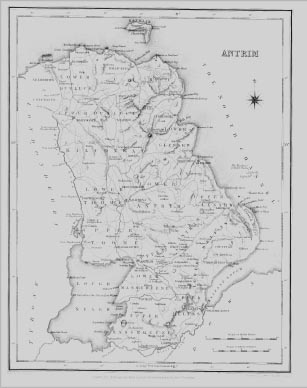| Accompanying Lewis map for Antrim 
|
| DUNEANE |
| DUNEANE, a parish, in the barony of UPPER TOOME, county of ANTRIM, and province of ULSTER, 6 miles (W. N. W.) from Randalstown, on the road from Belfast to Londonderry ; containing 6812 inhabitants. This parish is bounded on the west by Lough Beg and the river Bann, and on the south by Lough Neagh, in which, at the distance of half a mile from the shore, is a group called the Three Islands, which are within its limits. It comprises, according to the Ordnance survey, 13,128 statute acres, of which 1628- are in Lough Neagh, 415- in Lough Beg, and 29- in the river Bann. About two-thirds of the land are in a state of good cultivation, one-tenth is bog, and the remainder waste : the soil is fertile and the system of agriculture greatly improved. Basaltic stone is quarried in large quantities for building and for repairing the roads. The principal seats are Reymond Lodge, that of Earl O'Neill ; Moneyglass, of J. Hill, Esq. ; St. Helena, of Reford, Esq. ; and Brecart, of Capt. O'Neill. The weaving of calico and union cloths, and also of fine linen, is carried on extensively. The living is a vicarage, in the diocese of Connor, united from time immemorial to the rectory of Cranfield, and in the patronage of the Marquess of Donegal ; the rectory is impropriate in W. Cranston, Esq., of Belfast. The vicarial tithes, as returned by the Ecclesiastical Commissioners in 1831, amounted to £240, and of the whole union to £270 ; there is neither glebe nor glebe-house, The church is a small plain edifice, nearly in the centre of the union. The R. C. parish is co-extensive with that of the Established Church ; there are chapels at Moneyglass and Cargin, the former built in 1826. There is also a place of worship for Presbyterians in connection with the Synod of Ulster, of the third class. About 840 children are taught in nine public schools, of which the parochial school is aided by donations from the vicar ; and there are eight Sunday schools. There are some remains of a circular camp, called Ballydonnelly fort, similar to the Giant's Ring in the county of Down. |
| TOOME |
| TOOME, a post-town, in the parish of DUNEANE, barony of UPPER TOOME, county of ANTRIM, and province of ULSTER, 22? miles (W. N. W.) from Belfast, on the road to Londonderry, and 102? (N. by W.) from Dublin ; containing 122 inhabitants. This place, which gives name to the barony, had at a very early period a ford or ferry across the river Bann, which formed the only pass from one part of Ulster to the other, and on the first invasion of the English was considered to be of so much importance that De Courcey erected a castle here for its protection. It has been the scene of many sanguinary contests, its name being conspicuous in the history of all the insurrections that have occurred in this part of the country. In the parliamentary war the castle was surprised and taken by the R. C. bishop of Clogher, in 1650, but was soon after taken by Col. Venables, an officer in Oliver Cromwell's army, by whose orders it was subsequently dismantled. In the disturbances of 1798, a body of isurgents, after their defeat at Antrim, retreated from Randalstown to this place and posted themselves on the eastern side of the river, where they remained for two days, and on the approach of Gen. Knox, who was marching hither with 1500 of the yeomanry, to prevent the disaffected of Derry from joining them, they broke down one of the arches of the bridge, with a view to interrupt his progress. The town, which contains only about 20 houses, is situated on the eastern bank of the river Bann, over which in its short course from Lough Beg into Lough Neagh is a handsome bridge, erected at the sole expense of the late Earl O'Neill. It has a sub-post-office to Randalstown and Castledawson, and is a constabulary police station. In the court-house are held petty sessions every fortnight, and the court for the manor of Mullaghgane. Near the spot where the river unites with Lough Neagh is a good wharf with a commodious quay. Fairs are held on March 28th and Dec. 4th, and a pleasure fair is held at the bridge on Easter-Monday. The remains of the castle have fallen from the cliff and are scattered on the strand of Lough Neagh ; many cannon balls have been found near its site. |
|